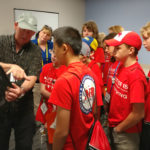Air Camp Gives Students Insight into the Science of Inflight Services
July 28, 2017

As a way of supporting community and education, PSA Airlines was a partner in Air Camp, a hands-on program that teaches intermediate and middle school students about aviation and aeronautics.
Nearly 100 students came to the PSA Dayton Training Center on July 12 and July 26 and learned about the duties of a flight attendant and how that role fits into the STEM (science, technology, engineering, and mathematics) teachings.
Check out a gallery of students in the training:
Instructors Kimberly Pennamon, Morgan Fussinger, Darcy Drago, Robin Coombs, Michelle Spangler and LC Acor, along with Manager of Inflight Training Andrea Roush participated in the tour for PSA.
Kimberly, a former teacher, led the discussion with the student groups. In the below Q&A, she talks about her experience.
Do you feel programs and tours like this help promote PSA and what you do as flight attendants? Yes, I believe that “gateway” opportunities such as the one that we provided help to foster and increase student interest in STEM areas. I am very hopeful that the students also felt that our discussion of examples of how the two areas integrate (our role as a flight attendant and the STEM areas) were relevant and helpful.
The presentation included a planned evacuation drill. What made you decide to include that part of the FA training?
Flight attendants serve as the “Safety Coordinator of the cabin.” It is our responsibility to evacuate the aircraft during an emergency. Since we were charged with providing information regarding the role of a flight attendant, we believed that it would be beneficial for the students to serve as participants of a planned emergency evacuation.
What did you tell the teachers and students about the role of flight attendants s and how it fits into STEM careers?
We showed our Scott Portable Oxygen Bottle (POB) and I asked if they knew the element for oxygen on the periodic table. I also explained that we have to know how to utilize the POB for medical emergencies to include looking to determine if it is odorless and colorless as well as whether there is a flow of oxygen as indicated by the specific type of oxygen bottle on the aircraft.
What takeaways did you get from your experience helping with Air Camp?
The takeaways that I got from the experience helping with Air Camp were:
- The need to continue to build and promote community partnerships with local entities such as the public school system. These can be used as early “gateway” opportunities which can serve as pathways to helping identify and recruit future flight attendants, pilots and essential airline personnel.
- The opportunity to provide students, who had never been on an airplane, the opportunity to sit in our cabin simulator and to provide them with a simulated airplane experience. Several weeks back, we were informed that the primary component of our revenue customer base are first-time flyers. As we polled the students from each Air Camp group, we learned that there were a few who had never been on an airplane.
- The response from a student who stated that he felt that it was the role of the flight attendant to be “compatible with incompatible people [passengers].” His words were so profound. I asked if we could borrow his statement. It, very appropriately, summarized the discussion of topics about security and customer service.
- The opportunity to emphasize the importance of education, learning and training to the students. We continued to inform them how critical it is that flight attendants act as lifelong learners and stay abreast of information (policies, procedures and regulations) to be able to possess and effectively demonstrate job knowledge and skill proficiency.
It was a very rewarding experience and I am looking forward to future visits by the Air Camp students and teachers. I hope that we will have more opportunities to partner with them and other organizational groups in the future.